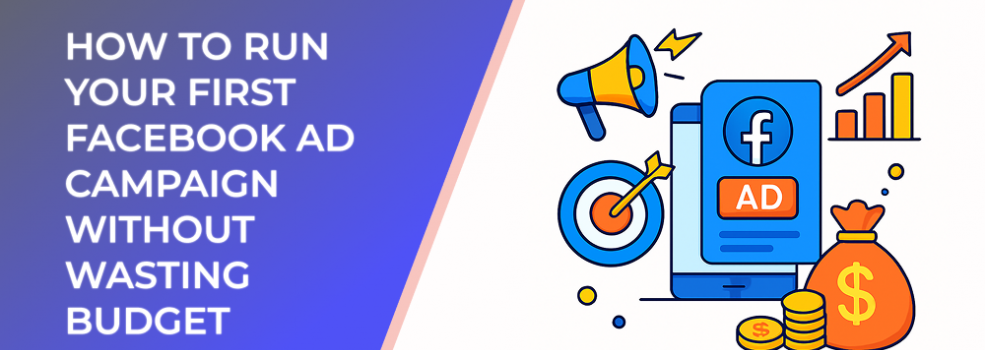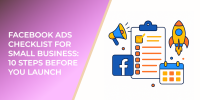If you’re a small business owner, marketer, or founder setting up your very first Facebook ad campaign—or you’ve tried once and watched the budget evaporate—this step‑by‑step playbook is for you.
What “not wasting budget” really means
-
Every dollar must have a job. Awareness, traffic, leads, or sales—pick one.
-
You measure outcomes, not clicks. Clicks are cheap; conversions pay the bills.
-
You test small, scale only what works. Start lean, grow deliberately.
Target outcome for your first 14 days: a testable funnel with clean data, 2–3 winning creatives, and a clear plan to iterate.
The 7‑Step Launch Plan (with checkpoints)
1) Define a single objective and KPI (10 minutes)
Choose one objective for your first campaign:
-
Leads (form fills, sign‑ups) → Primary KPI: Cost per lead (CPL)
-
Sales (purchases) → Primary KPI: Cost per acquisition (CPA), ROAS
-
Appointments (bookings) → Primary KPI: Cost per booking
Why it matters: New accounts with scattered objectives confuse delivery and burn budget. A clear goal tells the algorithm whom to find.
Benchmarks to aim for: In early tests, expect higher CPAs in week 1 that typically drop 15–30% by weeks 2–4 as learning completes, provided you keep consistent signals and budgets.
2) Set up measurement before a single dollar is spent (20–30 minutes)
-
Install the Meta Pixel on your site and verify events (ViewContent, AddToCart, Lead, Purchase).
-
Configure Aggregated Event Measurement with your top 4–6 prioritized events.
-
Turn on Advanced Matching to improve attribution.
Useful stats: Advertisers who track server‑side or enhanced signals often see 5–20% more attributed conversions and more stable optimization due to better match rates.
Checkpoint: Trigger a test conversion and confirm it appears in Events Manager within minutes.
3) Know your buyer and create a tight starting audience (15 minutes)
Start narrow enough to be relevant but not so tiny you starve delivery.
-
Core audience starter: Location + age + 2–4 interest clusters (e.g., "home fitness", "Pilates", "athleisure").
-
Lookalikes (if you have data): 1% LAL from purchasers or qualified leads.
-
Retargeting (if any traffic exists): 30‑day website visitors or engaged Instagram/Facebook users.
Useful stats: Fresh accounts typically see retargeting CPAs 20–50% lower than cold audiences. If you have no traffic yet, go cold first and build your retargeting pool.
Pitfall to avoid: Stacking dozens of interests over‑filters and increases CPMs. Aim for an initial audience size of 500k–5M (country‑dependent) for prospecting.
4) Choose the right campaign structure (10 minutes)
-
One campaign → one objective.
-
2–3 ad sets (audience variations).
-
2–3 ads per ad set (creative variations).
-
Use Advantage Campaign Budget (ABO or CBO) based on preference; for first campaigns, many advertisers start with ABO for control, then test CBO.
Useful stats: Accounts that reduce early complexity (≤ 3 ad sets, ≤ 3 ads each) often exit Learning 1–3 days faster and see 10–25% steadier CPA due to more concentrated data.
5) Budgeting that protects your wallet (5 minutes)
-
Set daily budget ≈ 3–5× your target CPA per ad set. If your target CPA is $20, start at $60–$100/day total across ad sets.
-
Minimum conversion volume: Aim for 50+ conversions per week per ad set to stabilize. If you can’t afford that, consolidate ad sets.
-
Avoid frequent budget edits during the Learning Phase; make ≤ 20% changes at a time.
Useful stats: Large budget swings can spike CPAs 10–40% for 24–72 hours as delivery re‑learns.
6) Craft creatives that do the heavy lifting (30–60 minutes)
Create three distinct concepts:
-
Problem‑solution (show pain → quick payoff).
-
Social proof (review, rating, UGC‑style testimonial).
-
Demonstration (before/after, short demo, carousel showcase).
Tips:
-
Hook in the first 2 seconds.
-
Use clear product/service visuals.
-
Put the value prop and CTA up front.
-
Keep videos 15–30 seconds; carousels 5–7 cards.
Useful stats: UGC‑style creatives often reduce CPAs 15–35% vs. polished studio ads in direct‑response categories.
7) Launch, watch the right metrics, and make calm changes
First 72 hours (Learning):
-
Don’t judge results too early. Expect volatility in CPM, CTR, and CPA.
-
Kill only obvious outliers (e.g., >2× your target CPA with no positive trend after 3 days and 1,500+ impressions).
Days 4–14 (Stabilization):
-
Shift budget to the top 1–2 ad sets.
-
Replace the bottom ad’s creative with a new concept; keep your winners running.
Key health metrics to monitor daily:
-
CPM (cost to reach): rising CPMs can signal weak creative or over‑targeting.
-
CTR (link): aim for ≥ 0.7–1.0% on cold traffic for most niches.
-
CVR (landing → lead/purchase): healthy funnels show 10–25% for lead gen, 2–5% for e‑commerce (varies by price/offer).
-
CPA / ROAS: your north stars.
Your 14‑Day New‑Account Game Plan
Day 0–1: Tracking live, one objective chosen, 2–3 audiences, 2–3 creatives.
Day 2–3: Launch. Verify events, check spend pacing, remove only non‑starters.
Day 4–7: Consolidate to winners, refresh one new creative, keep budgets steady.
Day 8–14: Scale +15–20% every 2–3 days on winners; test CBO or broader audiences; introduce light retargeting if pools are >1,000 users.
Scaling guardrails: If CPA jumps >25% after a change, revert and let delivery settle for 48 hours before trying again.
Common Budget Traps (and how to dodge them)
-
Wrong objective: Using Traffic when you want Leads. Result: cheap clicks, no outcomes. Fix: choose Leads or Sales.
-
Too many ad sets: Spreads data thin. Fix: 1–3 to start, then expand deliberately.
-
Creative fatigue: Same ad running for weeks. Fix: refresh concepts weekly until you have 2–3 durable winners.
-
Broken landing page: Slow load or unclear CTA. Fix: aim for <3s load time, clear headline, one action.
-
No retargeting: You pay to generate interest but never follow up. Fix: add 7–30 day engaged visitors once pools are ready.
Simple Launch Checklist
-
Pixel installed, events verified, Advanced Matching on.
-
One objective; KPI defined and written down.
-
Audiences: 1–2 cold, 1 retargeting (if available).
-
Structure: 1 campaign, 2–3 ad sets, 2–3 ads/ad set.
-
Budget: 3–5× target CPA/day; avoid large edits.
-
Creatives: 3 distinct concepts; clear hooks and CTAs.
-
Daily review: CPM, CTR (link), CVR, CPA/ROAS; act only on significant patterns.
If you’re stuck, debug in this order
-
Tracking → Are conversions firing? If not, fix before anything else.
-
Offer/Landing → Does the page convert at a reasonable rate? If CVR < 10% for lead gen, improve offer or clarity.
-
Creative → Is your CTR weak (<0.7%)? Swap in a stronger hook or proof.
-
Audience → Too narrow or irrelevant? Broaden interests or test broad with good creative.
-
Budget/Structure → Consolidate to give the algorithm enough signal.
Example Starter Setups
Local service (lead gen):
-
Objective: Leads.
-
2 ad sets: (A) radius + interests (problem‑based), (B) lookalike from past leads (if available).
-
Budget: $60/day total.
-
Creative: 1 UGC‑style video, 1 before/after image, 1 testimonial image.
-
KPI: CPL under $25 within 14 days.
E‑commerce (under $60 AOV):
-
Objective: Sales.
-
2 ad sets: (A) broad (18–55, no interests), (B) interest stack (category + complementary brands).
-
Budget: $75/day total.
-
Creative: 1 demo video, 1 carousel of USPs, 1 social‑proof ad.
-
KPI: Break‑even ROAS by day 10–14, scale winners.
Useful Statistics at a Glance
-
Expect 15–30% CPA improvement after the first 1–3 weeks as learning stabilizes and you prune losers.
-
UGC‑style ads commonly reduce CPA by 15–35% in direct‑response categories.
-
Retargeting pools (7–30 days) often deliver 20–50% lower CPAs than cold traffic, once audience size is sufficient.
-
Budget changes >20% can temporarily increase CPA 10–40% for 1–3 days.
-
Hitting ~50 conversions/week per ad set is a practical threshold for stable delivery.
Treat these as directional—not guarantees. Always validate against your own data.
Where to go next on LeadEnforce
Want to deepen your setup and troubleshooting? Read these next:
-
Facebook Ads Not Converting: How To Fix It — practical diagnosis from tracking to creative.
-
Meta Ad Campaign Objectives Explained: How to Choose the Right One — pick the objective that matches your KPI.
-
Facebook Ad Targeting 101: How to Reach the Right Audience — build smarter cold and retargeting segments.
Final word
Your first campaign doesn’t have to be perfect; it has to be clean, small, and measurable. Launch with one goal, protect the budget with a simple structure, and iterate based on data—not vibes. Do that, and your “test spend” becomes a repeatable system you can scale.

